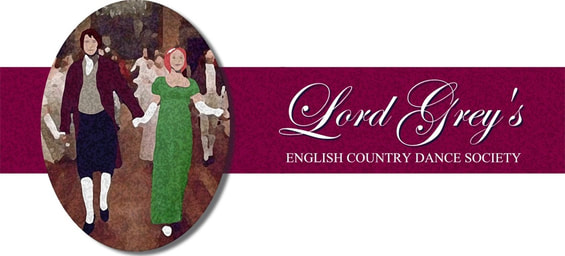Dances to check out:Seven Effective Aids to English Country DancingListen to the music: Find the basic beat and step on each beat. Fit your movements to the musical phrases. Distinguish between 2 steps and 3 steps per bar.
Dance with other people: This is a social, not solo form of dancing. Relate to your partner and all others you meet in the set. Dance with the whole room: Keep lines straight by keying on the couple at the top of the set. Be alert to help others who are momentarily confused, in a friendly manner. Maintain elegant carriage: Stand tall and proud, head centred on shoulders, shoulders centred on hips, body weight slightly forward. Connect firmly when taking hands: Don't be afraid to hold hands firmly. In turning movements, share equal tension with others to enhance the splendid effect of the turn. Keep arms at a comfortable height. In taking hands, men offer palms up and women offer palms down. The man always supports the lady's hand.Feel serene, buoyant and joyful: Cultivate a springy, light dance step and avoid shuffling. Match your mood to the music and the particular dance.Take responsibility for the patterns: Listen carefully to the caller's instructions and prompts. Find the learning methods that work best for you. Visualize the geometry of the dance. Think ahead and know where you are going to ensure glorious, smooth transitions between figures.
|
The DanceWhat is English Country Dancing? Picture Jane Austen's "Pride & Prejudice" Ball Scene and imagine enjoying this graceful form of dance, the elegance, the music and the beautiful costumes.
All English Country Dances are "called" dances and take a variety of forms which include lines, squares and circles. They are leisurely, fun-filled social dances suitable for the young at heart of all ages. It requires mental concentration and alertness which stimulates the brain and promotes a sense of both mental and physical wellbeing. This form of dance promotes social interaction. Historical reconstructions and modern interpretations have produced the present 21st Century form of English Country Dance which is now in a revival period. Groups now preform in Toronto, Hamilton, London, Ottawa and Kingston as well as in other Canadian and U.S.A. Cities. Spencerville holds an annual Regency Ball and this year it will be held on May 23 to 25, 2014. Check out their website at www.spencervilleECD.org. Dance TermsArm right (or left) -- couples link right (or left) arms and move forward in a circle, returning to their starting position.
Back to back -- facing another person, move forward Cast up (or down) --turn outward and dance up (or down) outside the set. Cross hands --face and give left to left and right to right. Cross over --cross with another dancer passing right. Gypsy --two danceers move around each other in a circular path while facing each other. Hey --a weaving figure i which two groups of dancers move in single file and in opposite directions. Honour --couples step forward and right, close, shift weight and curtsey or bow, then repeat to their left. Lead --couples join inside hands and walk up or down the set. Neighbour --the person you are standing beside, but not your partner. Pass --change places with another dancer moving forward and passing by the right shoulder, unless otherwise directed. Proper --with the man on the left and the woman on the right, from the perspective of someone facing the music. Set --a dancer steps right, closes with left foot and shifts weight to it, then steps back to the right foot (right--together--step) then repeats the process mirror image (left--together--step). Siding --two dancers, partners by default if not otherwise specified, go forward in four counts to meet side by side, then back in four counts to where they started the figure. Slipping circle (left or right) --dancers take hands in a circle (facing in) and chasse left or right. Star --some number of dancers (usually four) join right or left hands in the middle of their circle (facing either CW or CCW). The dancers circle in the direction they face. Swing --a turn with two hands, but moving faster and making more than one revolution. Hay of Three = view attached link https://www.youtube.com/watch?v=R8lMP0k7 |
|
"CDSS News #159"
"Joyce Crouch" |
